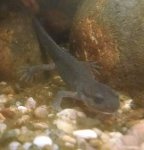tyjorg
New member
Hello, I am a teacher and last school year for a class project we hatched rough skinned newts from a egg sack we found in a pound. 11 hatched and are still alive today. We are just wondering when they will be ready to get out of the water, we thought it would be now, but they seem content in the water. They hatched in late February so around 7 months old.
Another thing, we got some brine shrimp eggs we are going to hatch and feed to the fish we have in the class and were thinking about the newts. Is this a good idea? Do brine shrimp live in fresh water long enough to get eaten? Thanks.
Tyler
Another thing, we got some brine shrimp eggs we are going to hatch and feed to the fish we have in the class and were thinking about the newts. Is this a good idea? Do brine shrimp live in fresh water long enough to get eaten? Thanks.
Tyler


 Ambystoma Enthusiast
Ambystoma Enthusiast




